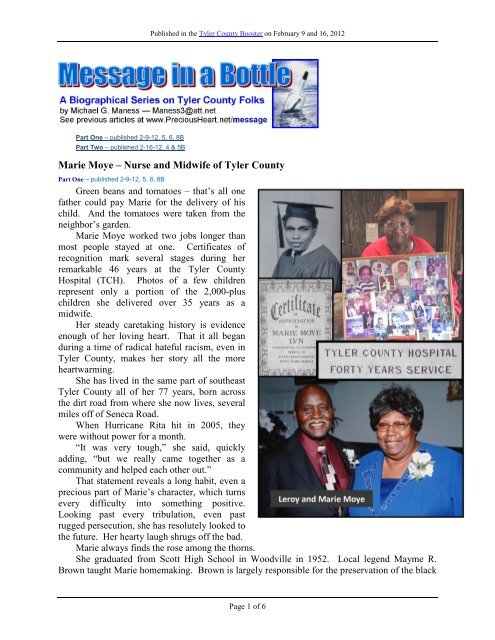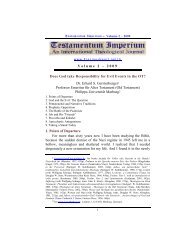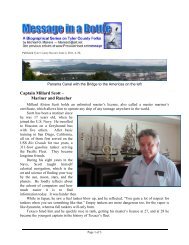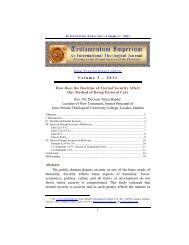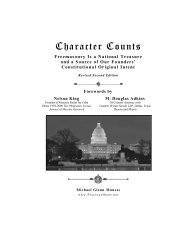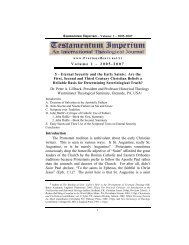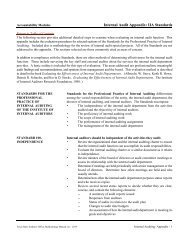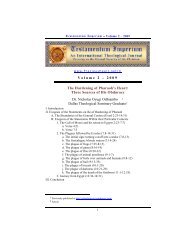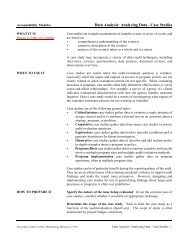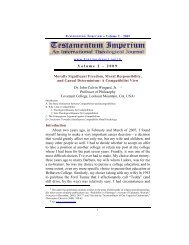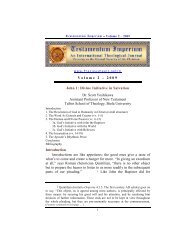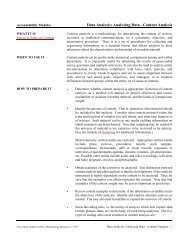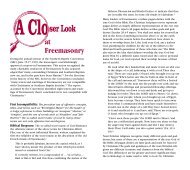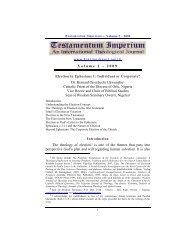Marie Moye - Nurse and Midwife of Tyler County - PreciousHeart.net
Marie Moye - Nurse and Midwife of Tyler County - PreciousHeart.net
Marie Moye - Nurse and Midwife of Tyler County - PreciousHeart.net
Create successful ePaper yourself
Turn your PDF publications into a flip-book with our unique Google optimized e-Paper software.
<strong>Marie</strong> <strong>Moye</strong> – <strong>Nurse</strong> <strong>and</strong> <strong>Midwife</strong> <strong>of</strong> <strong>Tyler</strong> <strong>County</strong>history in <strong>Tyler</strong> <strong>County</strong> <strong>and</strong> authored Historical Documentary <strong>of</strong> the Henry T. Scott School(1998).<strong>Marie</strong> remembers the courtship between Mayme <strong>and</strong> John Canada, a discreet <strong>and</strong> lovingadventure in itself. <strong>Marie</strong> will not tell much there, which reveals more about herself.Along with her faith in God, perhaps one key to <strong>Marie</strong>’s positive outlook has been theability to keep a confidence, hold a secret, at times overlooking the uglier things in life, includingholding in trust the shame <strong>of</strong> deep poverty within many <strong>of</strong> the homes she visited.While chatting with <strong>Marie</strong>, home health nurse Linda Hughes dropped by. Linda had workedwith <strong>Marie</strong> at the TCH years ago. Linda helped the hesitant <strong>Marie</strong> to open up.“Tell it like it was,” Linda, a white woman, encouraged.Everyone must know that it is hard for a kind heart, like <strong>Marie</strong>, to share the uglier side <strong>of</strong>racial hatred with a white newspaper man, even these years later.While checking <strong>Marie</strong>’s heart rate, nurse Linda said, “You have no idea how hard it was fora black person back then.” That has been repeated before, by white <strong>and</strong> black persons, yet has apersonal touch as we sit around the table with <strong>Marie</strong> who lived through it all.<strong>Marie</strong> began at the TCH in 1954 as a maid scrubbing floors, cleaning bed pans, thenpromoted to the kitchen. It was hard work.Just as racial integration came to southeast Texas, Iona Conner encouraged <strong>Marie</strong> to enterLamar University’s nursing program. <strong>Marie</strong> reflected, “Mrs. Conner said ‘They are letting blackpeople go.’ She said she would bring the application.”Among the first five black women to enter Lamar’s nursing program, <strong>Marie</strong> was the onlyone to stay. The racial hatred drove the other four away.Several parents <strong>of</strong> Lamar students threatened <strong>Marie</strong>, <strong>and</strong> one day they forced her to leavetown.“Do not come back,” they said. The threats were real.“I ended up taking care <strong>of</strong> one <strong>of</strong> those parents in the hospital who had threatened me. I didmy best by her,” said <strong>Marie</strong>, smiling s<strong>of</strong>tly, determined to do what was right.She almost did not return to school, but Dr. Watt Barclay encouraged <strong>Marie</strong> to stay.<strong>Marie</strong> said under her breath, “It was easy for him to say that as a white man.” Yet there wasa serious tone in the doctor’s encouragements. She believed him <strong>and</strong> went back to school.Barclay came to Woodville in 1933, started the first hospital in an old house, then became chief<strong>of</strong> staff <strong>of</strong> TCH, passing away in 1959.Dr. Barclay had gotten a hold <strong>of</strong> the city <strong>of</strong> Beaumont <strong>and</strong> the school. Though he could notstop the hatred, he did get the police into action.<strong>Marie</strong> had to park <strong>of</strong>f campus, where a police <strong>of</strong>ficer would be waiting, <strong>and</strong> then escort herto school. Another would escort her out every day.<strong>Marie</strong> had to face hatred every day for the entire program.Among the many challenges, she could not use the regular restrooms. They were “white”restrooms. Equality was the law, but fiercely resisted. Nor could <strong>Marie</strong> use the cafeteria. Shehad to take her lunch with her <strong>and</strong> eat inside the classroom. She essentially stayed in theclassroom all day, until it was time to go home.When she graduated from Lamar in 1957, the school administrators did not even put a dateon her diploma. Among several recognitions, she showed a letter dated 2011 from LamarPresident James Simmons, who said he was “proud” <strong>of</strong> her 1957 degree. Better late than never,one supposes, <strong>and</strong> he congratulated her lifetime <strong>of</strong> service, saying the impact <strong>of</strong> her “importantwork has affected our entire region.”Page 2 <strong>of</strong> 6
<strong>Marie</strong> <strong>Moye</strong> – <strong>Nurse</strong> <strong>and</strong> <strong>Midwife</strong> <strong>of</strong> <strong>Tyler</strong> <strong>County</strong>She almost went to work in Houston, then her father got sick, <strong>and</strong> she came back toWoodville <strong>and</strong> Married Leroy <strong>Moye</strong> in 1959. They have been together ever since. They adoptedfive children, the latter four from within the family: Demetrius, Madeline, Glen, Rachel, <strong>and</strong>Megan.“I treat them all the same,” she said.<strong>Marie</strong> could be a maid at the TCH; no one had a problem with that. But to be a nurse wasanother matter. The TCH Board <strong>of</strong> Directors was not certain they wanted a black nurse. Severaldid not want her as a nurse.Dr. Barclay asked, “How do you like your white women bathing a black man?” That blatantremark, among others, helped shed light on the fact that his black patients were not getting thesame care as the white ones. It was a battle, but Dr. Barclay won.<strong>Marie</strong> became the TCH’s first African American nurse in 1958.“It was still hard,” <strong>Marie</strong> said, “we had to say ‘Mr.’ or ‘Mrs.’ to every white person, nomatter how old they were. Even to a baby <strong>and</strong> a little child.”Dr. Barclay recruited Dr. Bob Swearingen in 1956, who joined with Drs. Gilchrist <strong>and</strong>Burton to serve the TCH.“She was a good cook,” said Dr. Swearingen, reflecting his first encounter. “They had notintegrated yet. <strong>Marie</strong> was the first black nursing graduate <strong>of</strong> Lamar, if I remember right. Shebecame a good scrub nurse. Then she began to help deliver babies as a midwife. She had goodjudgment about it. <strong>Marie</strong> said to me, ‘I want you to promise me, when I need a C-section, you’llcover for me.’”Dr. Swearingen laughed. “About once or twice a year, I would get a call: ‘<strong>Marie</strong> is bringingone for you.’ I’d say, ‘Then get ready. If she cannot deliver it, I cannot either.’”Dr. Gayle Burton was always worried about disease. He became worried about shoes <strong>and</strong>decided they were too unsanitary, collecting dried blood on them. He told <strong>Marie</strong> to put them inthe autoclave, a small sterilizing oven, to cleanse them. They came out about half their normalsize. Dr. Swearingen laughed as he recalled those days.<strong>Marie</strong> was never late for surgery. But sometimes, when there was nothing going on, shewould be a little late. A new administrator, a Ms. Kent, was gung-ho <strong>and</strong> fired <strong>Marie</strong>.As <strong>Marie</strong> was leaving that day, Dr. Swearingen was arriving.Part Two – published 2-16-12, 4 & 5B“Where are you going?” he asked.“Home. She fired me,” she replied.“She can’t fire you. You go get your stuff. You’re not going anywhere.” He fixed it.Reflecting back then, Dr. Swearingen said, “She was the only scrub nurse we had. I dearly lovedher. Still do. Great spirit.”Yet, she is afraid <strong>of</strong> dead people. Does not really know why. She reflected back to hertraining at the old Municipal Hospital in Beaumont <strong>and</strong> all <strong>of</strong> the charity patients she workedwith there. Reflected on the ghost stories <strong>and</strong> such.Then, with a laugh, she recalled how they used a hearse!“There were no ambulances then. They had a special c<strong>of</strong>fin made to transfer patients fromWoodville to Beaumont, <strong>and</strong> we had to call the funeral home to get the hearse.” <strong>Marie</strong> smiledbroadly, knowing this was a bit <strong>of</strong> shock. “They used the same vehicle to transfer the living <strong>and</strong>the dead.”She helped out with surgery, <strong>and</strong> a lot <strong>of</strong> stories could be told.Page 3 <strong>of</strong> 6
<strong>Marie</strong> <strong>Moye</strong> – <strong>Nurse</strong> <strong>and</strong> <strong>Midwife</strong> <strong>of</strong> <strong>Tyler</strong> <strong>County</strong>“Surgery?” she questioned, “They would talk about everything during surgery, but thesurgery.” Then she hesitated, always discreet. “Some <strong>of</strong> that I am not going to tell.”At the TCH, she was a black nurse, but she could not eat in the dining room.“I could not eat until everyone else had left the dining room. Also, the white nurses wouldgo <strong>and</strong> sit down, <strong>of</strong>ten, <strong>and</strong> I had to mop the floor.” <strong>Marie</strong> kept her spirits <strong>and</strong> recalled, “Dr.Swearingen would come in <strong>and</strong> bring me a thing <strong>of</strong> orange juice … sometimes he would mop thefloor. He saw. He was a good person.“They promised me one salary,” she continued, “but did not give it. They paid me less thanthe white nurses. Any dirty work … I had to do it. The white uniform did not mean much. AtChristmas time, one <strong>of</strong> the board members bought all the white nurses a ham, but not me.“Did it all. Primarily, I was to take care <strong>of</strong> black people, but ended up taking care <strong>of</strong>everyone.”For 46 years!“I saw some good days <strong>and</strong> some bad days … but going to count them all good days.”In 1963, <strong>Marie</strong> reluctantly started another pr<strong>of</strong>ession.“Inez Williams’ daughter-in-law was going to have a baby. She did not have the money.They asked me to help,” <strong>Marie</strong> said. “We had an agreement,” nodding, as firm today as she musthave been then. “They were not going to tell anybody. Then a friend <strong>of</strong> Inez needed help, <strong>and</strong>then another <strong>and</strong> another.”<strong>Marie</strong> became the person to call.“We had no telephone,” she said, “they would come <strong>and</strong> get me. Or bring the pregnant ladyto my house. I delivered three babies in one day in my own home. Sometimes I would wake thechildren up in the middle <strong>of</strong> the night. I’d get my children up <strong>and</strong> send them to my bed, becauseI needed their bed to deliver a baby.“For 35 years, I was a midwife. I saw the second generation come, delivering the baby <strong>of</strong> amother I had delivered. Some say the count was over 2,000 babies.”As <strong>Marie</strong> was helping mothers throughout the <strong>Tyler</strong> <strong>County</strong>, several national nursing groupsreorganized, <strong>and</strong> the American College <strong>of</strong> <strong>Nurse</strong>-Midwives incorporated in 1955 (<strong>Midwife</strong>.org).When Varney’s <strong>Midwife</strong>ry came out in 1984, the midwife’s “bible” today, <strong>Marie</strong> had beendelivering for 20 years. Remarkably, in 2012 the Center for Disease Control reported that homebirths had “a lower risk pr<strong>of</strong>ile than hospital births” (CDC.gov).“The hospital charged $50 back then,” <strong>Marie</strong> said. “I started at $5, then over the yearsraised the price to $10, then $15 … the last one was $75. I went all over these woods deliveringbabies. Zavalla, Jasper … don’t know how many I delivered at the reservation…. Hillister,Doucette, Moss Hill.”“One time there was a 13-14 pound baby coming. I called my husb<strong>and</strong> to help push on thegirl’s stomach. He would not come! He stayed at the dining room table.”Leroy said, “I had a time book, working in the woods, <strong>and</strong> I wrote in it, ‘Jesus, Jesus, Jesus.’Then I said, ‘Lord, I do not know where to push. Or how to push. You know how to push. Youknow where to push. You do it! I am not going in there.”A couple <strong>of</strong> minutes later, the baby came.“I got my lunch <strong>and</strong> went to work,” Leroy said.“I did a lot <strong>of</strong> praying,” <strong>Marie</strong> said. “People did not realize how dangerous it was to delivera baby.”What were the clues that something was going wrong?Page 4 <strong>of</strong> 6
<strong>Marie</strong> <strong>Moye</strong> – <strong>Nurse</strong> <strong>and</strong> <strong>Midwife</strong> <strong>of</strong> <strong>Tyler</strong> <strong>County</strong>“Sometimes the cord on the placenta would break. If you did not get all <strong>of</strong> the placenta out,the mother could get infected. Sometimes the mother could hemorrhage.“Color <strong>of</strong> the embryotic fluid,” she said, “if it was green looking, then the baby was indistress. Or the cord could be around its neck. I had to determine if the baby was ‘head first’ ora ‘breech.’ A breech meant a feet-first baby. The head is the largest part, <strong>and</strong> if it came first, therest <strong>of</strong> its little body would follow. But feet first! The head might get stuck.”As <strong>Marie</strong> reflected the stories began to flood her memory.“The veil over the baby’s face … if the baby came out with part <strong>of</strong> the placenta over itshead, it could suffocate. Or if the cord drops out before the baby comes … you have to makesure cord stayed on the inside. Have to make sure the cord did not get clamped <strong>of</strong>f or getwrapped around the baby’s neck.“Some babies – you had to give mouth-to-mouth.”<strong>Marie</strong> has a corkboard with several pictures <strong>of</strong> the children she delivered, just a few that theparents sent to her. There was a collection <strong>of</strong> nine children <strong>of</strong> various ages from one mother.What did you do to prepare?“Have you ever seen a delivery?” she asked.“No.”“You really do not know much, do you?” she asked with big eyes <strong>and</strong> a big smile.“No, really do not.”“Need a clean area,” she continued. “Clean bed. I’d carry my stuff. I brought rags I hadsterilized in my own stove. I’d place a plastic bag on the bed, then a white clean rag to keep itclean. Sometimes the parents did not have any baby clothes. Sometimes they could not evenafford diapers, <strong>and</strong> I would have to give them their first cloth diapers. No Pampers back then. Itwas about three-four dollars for a pack <strong>of</strong> Birdseye diapers.“They had to cramp to get the baby out, <strong>and</strong> they had to cramp to get the placenta out.Sometimes they would have trouble with the placenta. We put some turpentine <strong>and</strong> hot water onthe belly to induce a cramp to get the placenta out.”<strong>Marie</strong>’s experience flooded the room. It was easy to see how her competence <strong>and</strong>confidence must have been a relief to new parents.“One time in Spurger, way back in the woods, a couple had no money at all. The new fatherwent to the neighbor’s garden <strong>and</strong> got some tomatoes out <strong>of</strong> the garden. Then out <strong>of</strong> his deepfreeze, he got some string green beans. Got some green beans <strong>and</strong> tomatoes for delivering ababy. They were good too.”“One time I got a big bottle <strong>of</strong> soda water for delivering. When I got home, my family triedto laugh at me, but they wanted that soda water too.”She delivered a baby in the back <strong>of</strong> a horse trailer. She delivered several in parking lots.“You cannot predict when a baby is coming,” she said.“One time I breathed for a baby from Woodville all the way to Galveston. The baby made it<strong>and</strong> is a grown man now. I call him my ‘Miracle Baby.’ His name is John, lives in Silsbee.”She points to his high school graduation photo on her corkboard.“I went to this old house in Woodville. No lights in that house. Amazing thing. I went in todeliver, near the Pleasant Hill Baptist Church. Old house. No lights. I sent the daddy to getsome coal oil for the lamp, but he never came back. Then, like a miracle, the street light seemedto shine so bright. Seemed to light up the room … Thank God.”There was a pause. Precious memories.Page 5 <strong>of</strong> 6
<strong>Marie</strong> <strong>Moye</strong> – <strong>Nurse</strong> <strong>and</strong> <strong>Midwife</strong> <strong>of</strong> <strong>Tyler</strong> <strong>County</strong>“Another time, I had this coal oil lamp at the foot <strong>of</strong> the bed, the only light. The dish panbelow. I told the mother, ‘If you holler <strong>and</strong> kick, you’ll knock over the coal lamp <strong>and</strong> set yourbehind on fire, <strong>and</strong> mine too!’ She did not budge. It was hard <strong>and</strong> funny too.“One reason I do not like to talk about it all too much … [she pauses] Ronnie Bean wasdoing this before me. She told me, ‘When you go into these homes, you do not bring anythinginto the home, <strong>and</strong> you do not bring anything out. Do not talk about it. No matter theconditions.’ I remembered that. Some <strong>of</strong> the homes were not suitable. Some were clean. Somewere not. I was there for one purpose. I was there to deliver the baby. A baby was coming intothe world … <strong>and</strong> I am just NOT going to talk about what I see.“Black or white … so many were so poor. They needed someone to help them get that babyinto the world.”<strong>Marie</strong> retired from both pr<strong>of</strong>essions in 1999. She had cancer, <strong>and</strong> she has diabetes <strong>and</strong>pulmonary hypertension. It is a struggle to get around tethered to oxygen all day <strong>and</strong> night. Sheis slower.“I think I am doing very well,” she said. “I am so blessed. I am so thankful that I don’t letmy health bother me.” <strong>Marie</strong>’s physical heart is wearing out, though her spiritual heart isstronger than ever. As midwife <strong>of</strong> <strong>Tyler</strong> <strong>County</strong>, there are countless mothers who hold <strong>Marie</strong> intheir hearts too, as the person who safely delivered their babies – as only a mother can fullyappreciate.Page 6 <strong>of</strong> 6


